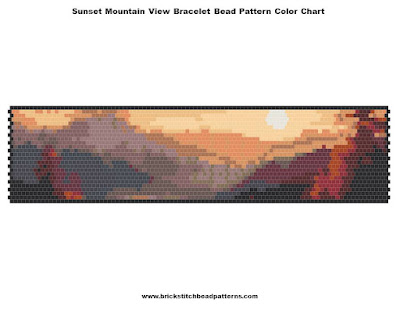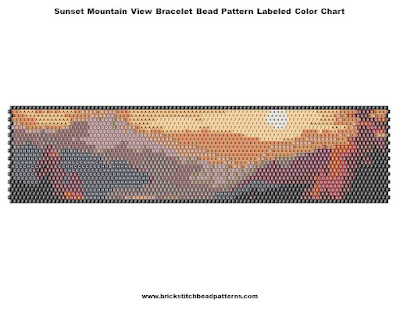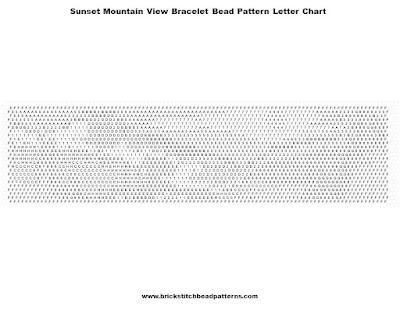Free Landscape Art "Sunset Mountain View" brick stitch, peyote stitch, or gourd stitch seed bead weaving art graph pattern. Scroll down for the free bead pattern color chart graph, labeled color chart graph, a letter chart graph that is similar to a word chart, and a bead count list. This bracelet was designed for using size 11 Miyuki Delica seed beads.
Tip the designer and buy me a coffee at
Bead Pattern Color Chart:
You can use this pattern color chart as a guide to what your finished beadwork piece should look like. The size and shape of your finished piece may vary slightly from the image below depending on the bead you use. However, this chart gives you a really good overview of the finished beadwork. Click on the bead pattern color chart to view a larger image of it.
 |
| Free Sunset Mountain View Bracelet Brick Stitch Bead Pattern Color Chart |
Support this blog and buy me a coffee at
A Note on Bead Sizes and Brands:
The size and brand of bead you use may affect the final look of the pattern. Miyuki Delicas and Toho beads look the best and have a classy feel. While on the pricey side, they are well worth the cost in how easy they are to bead and the beauty of the finished beadwork. I prefer the Perler Mini Beads for my beadwork. Along with a low price tag, they brick stitch really well and have a fun and whimsical look. They are also great for beaders who don’t see well or young beaders who might have trouble with tiny beads. Their size also makes for great brick stitch beaded ornaments and key chain dangles. (My favorite to bead.)
Pattern Size:
Width: 97 beads
Height: 27 beads
The size and brand of bead you use may affect the final look of the pattern. Miyuki Delicas and Toho beads look the best and have a classy feel. While on the pricey side, they are well worth the cost in how easy they are to bead and the beauty of the finished beadwork. I prefer the Perler Mini Beads for my beadwork. Along with a low price tag, they brick stitch really well and have a fun and whimsical look. They are also great for beaders who don’t see well or young beaders who might have trouble with tiny beads. Their size also makes for great brick stitch beaded ornaments and key chain dangles. (My favorite to bead.)
Width: 97 beads
Height: 27 beads
Beading Skill Level:
Intermediate
Bead Pattern Labeled Color Chart:
These charts are my favorite to use. They combine the color chart and letter chart so you can easily see by the letters which bead to use while simultaneously allowing you to compare your beaded piece to what the finished piece should look like. Printers do not always print the pattern colors correctly. So, having the letters on the pattern color chart, like the one below, can help differentiate colors that are close in hue. Click on the labeled bead pattern color chart to view a larger image of it.
Pattern Bead Counts:
Use these bead counts as a shopping list or to check that you have enough beads to complete your project. A typical 7 gram tube of size 11 seed beads average around 1200-1500 beads per tube. Here is a handy list of the approximate number of beads per 1 gram of each common size:
Use these bead counts as a shopping list or to check that you have enough beads to complete your project. A typical 7 gram tube of size 11 seed beads average around 1200-1500 beads per tube. Here is a handy list of the approximate number of beads per 1 gram of each common size:
Size 15 beads = 250 beads
Size 11 beads = 120 beads
Size 10 beads = 100 beads
Size 8 beads = 40 beads
Miyuki Delica 11/0 Bead Count:
Miyuki Delica 11/0 Bead Count:
Chart #:1 DB-87 Root Beer Lined Light Topaz AB Count:159
Chart #:2 DB-184 Silver Lined Dark Taupe Count:70
Chart #:3 DB-272 Goldenrod Lined Topaz AB Count:154
Chart #:4 DB-673 Antique Ivory Satin Count:23
Chart #:5 DB-777 Frosted Transparent Topaz Count:132
Chart #:6 DB-1392 Dark Topaz Lined Rootbeer Count:147
Chart #:7 DB-1561 Opaque Pear Luster Count:192
Chart #:8 DB-1584 Matte Opaque Currant Count:151
Chart #:9 DB-1683 Silver Lined Glazed Dark Topaz Count:46
Chart #:A DB-1691 Silver Lined Glazed Dark Saffron AB Count:147
Chart #:B DB-1692 Silver Lined Glazed Dark Honey AB Count:121
Chart #:C DB-1872 Color Lined Rustic Grey AB Count:128
Chart #:D DB-1880 Color Lined Hydrangea AB Count:159
Chart #:E DB-1892 Transparent Sable Brown Luster Count:175
Chart #:F DB-1910 Matte Opaque Espresso Count:442
Chart #:G DB-2119 Opaque Jujube Duracoat Count:62
Chart #:H DB-2144 Opaque Cobalt Count:129
Total Bead Count: 2437
Chart #:1
DB-87 Root Beer Lined Light Topaz AB
Count:159
Chart #:2
DB-184 Silver Lined Dark Taupe
Count:70
Chart #:3
DB-272 Goldenrod Lined Topaz AB
Count:154
Chart #:4
DB-673 Antique Ivory Satin
Count:23
Chart #:5
DB-777 Frosted Transparent Topaz
Count:132
Chart #:6
DB-1392 Dark Topaz Lined Rootbeer
Count:147
Chart #:7
DB-1561 Opaque Pear Luster
Count:192
Chart #:8
DB-1584 Matte Opaque Currant
Count:151
Chart #:9
DB-1683 Silver Lined Glazed Dark Topaz
Count:46
Chart #:A
DB-1691 Silver Lined Glazed Dark Saffron AB
Count:147
Chart #:B
DB-1692 Silver Lined Glazed Dark Honey AB
Count:121
Chart #:C
DB-1872 Color Lined Rustic Grey AB
Count:128
Chart #:D
DB-1880 Color Lined Hydrangea AB
Count:159
Chart #:E
DB-1892 Transparent Sable Brown Luster
Count:175
Chart #:F
DB-1910 Matte Opaque Espresso
Count:442
Chart #:G
DB-2119 Opaque Jujube Duracoat
Count:62
Chart #:H
DB-2144 Opaque Cobalt
Count:129
Total Bead Count: 2437
Bead Pattern Letter Chart:
Bead Pattern Letter Chart:
The bead pattern letter chart gives you a strictly black and white option for easy printing. It is simple to follow the pattern with the letters and functions similarly to a bead word chart. You can also print this chart out and color over the letters to see what different bead colors would look like in the pattern. Click on the bead pattern letter chart to view a larger image of it.
Suggested Beading Techniques to Use:
-Flat Brick Stitch-Ladder Stitch Base Row
*The brick stitch bead decreases are performed at the beginning and ending of rows.
-Flat Brick Stitch-
Ladder Stitch Base Row
Basic Brick Stitch
Single Bead Brick Stitch Decrease
Single Bead Brick Stitch Increase
Multiple Bead Brick Stitch Increase
Multiple Bead Brick Stitch Decrease
*The brick stitch bead decreases are performed at the beginning and ending of rows.
Suggested Beaded Base Row:
I suggest using the longest row as your base row and work the top portion of your pattern. Then, move your thread back to the beginning of your first row and work the bottom portion of the pattern.
Tools You Might Need For This Pattern:
I suggest using the longest row as your base row and work the top portion of your pattern. Then, move your thread back to the beginning of your first row and work the bottom portion of the pattern.
Tools You Might Need For This Pattern:
-Small Scissors-
-Small Scissors-
-A pencil to mark off finished rows on the printed pattern-
-Clear Nail Polish or Super Glue to secure thread knots.-
-Tape wrapped Needle Nose Pliers for pulling the needle and attaching jump rings-
-Rounded Nose Pliers for attaching jump rings-
Brick Stitch Beading Tips:
-For your base row, start with the row that has the most beads. Typically, this is a central row in the pattern. Then, brick stitch up the pattern. Once the top portion is complete, move your thread down to the base row and brick stitch the bottom portion of the pattern. This pattern can be beaded with brick stitch, peyote, and gourd stitch beading techniques. Print out the pattern and decide which row will be your base row. Then, number each row of the pattern so it is easier to follow and track your progress. This allows you to personalize how you brick stitch your pattern a little more.-Wax your thread with either beeswax or household paraffin to reduce knotting and allow your needle and thread to pass through beads more easily. Simply draw your working thread across the wax block to wax it. Be careful not to apply too much wax or it will chalk up on your beads and create a mess. Using beeswax will reduce the possibility of chalking, but household paraffin is cheaper and better for the bees.-If you have trouble passing your needle and thread through a bead, grip it with a pair of needle nose pliers that have had the nose wrapped in duct tape or electrical tape. You will have better grip on your needle with them and the tape will reduce any damage to your needle and beadwork.-Coat your knots with a clear nail polish to ensure they do not unravel.-The type of light you use when beading will affect how you see the bead colors. Bright florescent or LED lights work the best for seeing the true colors of the beads. However the florescent lights may be hard on the eyes. Fully light your work space so your eyes do not strain when trying to see the holes of tiny beads.
-For your base row, start with the row that has the most beads. Typically, this is a central row in the pattern. Then, brick stitch up the pattern. Once the top portion is complete, move your thread down to the base row and brick stitch the bottom portion of the pattern. This pattern can be beaded with brick stitch, peyote, and gourd stitch beading techniques. Print out the pattern and decide which row will be your base row. Then, number each row of the pattern so it is easier to follow and track your progress. This allows you to personalize how you brick stitch your pattern a little more.
-Wax your thread with either beeswax or household paraffin to reduce knotting and allow your needle and thread to pass through beads more easily. Simply draw your working thread across the wax block to wax it. Be careful not to apply too much wax or it will chalk up on your beads and create a mess. Using beeswax will reduce the possibility of chalking, but household paraffin is cheaper and better for the bees.
-If you have trouble passing your needle and thread through a bead, grip it with a pair of needle nose pliers that have had the nose wrapped in duct tape or electrical tape. You will have better grip on your needle with them and the tape will reduce any damage to your needle and beadwork.
-Coat your knots with a clear nail polish to ensure they do not unravel.
-The type of light you use when beading will affect how you see the bead colors. Bright florescent or LED lights work the best for seeing the true colors of the beads. However the florescent lights may be hard on the eyes. Fully light your work space so your eyes do not strain when trying to see the holes of tiny beads.






